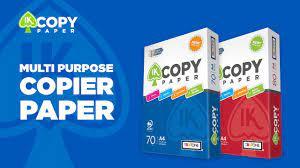In the printing world, paper is the canvas upon which ideas and information come to life. When producing high-quality prints, using the right copier paper is essential. Professional copier paper, designed to meet the stringent demands of modern printing, ensures that every photo comes out perfectly, leaving a lasting impression.
The Importance of Quality Copier Paper
Copier paper might seem like a simple and inconspicuous office supply, but its role in printing is significant. When dealing with critical documents, presentations, or marketing materials, the quality of the copier paper can make a substantial difference in the final result.
High-quality copier paper enhances the printing experience by delivering sharp, clear prints with vibrant colors and precise text. On the other hand, using subpar copier paper can lead to issues such as smudging, bleeding, and paper jams, which can disrupt workflow and compromise the integrity of printed materials.
Characteristics of Professional Copier Paper
Professional copier paper is precisely engineered to meet the needs of modern printing technologies. Several vital characteristics set it apart from standard copier paper:
Weight and Thickness
Professional copier paper is usually heavier and thicker than regular paper. The weight is measured in grams per square meter (gsm). A higher gsm indicates a broader and more substantial form, which reduces the risk of paper curling, enhances durability and gives documents a more substantial feel.
Brightness and Whiteness
Brightness and whiteness are essential factors in copier paper. Brightness refers to how much light the report reflects, affecting the overall contrast and readability of the printed content. High brightness levels ensure crisp text and vivid images.
Whiteness, on the other hand, refers to the color of the paper. Professional copier paper is typically brighter and whiter, providing an excellent background for vibrant prints and ensuring that colors appear true and accurate.
Smoothness
The surface smoothness of professional copier paper is another crucial characteristic. Smooth paper reduces friction in the printing process, preventing issues such as paper jams and ensuring consistent ink or toner adhesion. It also contributes to sharp image reproduction and clear text.
Archival Quality
Professional copier paper is often designed to be archival quality, meaning it is acid-free and lignin-free. These properties ensure that the paper resists yellowing and deterioration over time, making it suitable for long-term storage and preserving the integrity of essential documents.
Applications of Professional Copier Paper
Professional copier paper finds a wide range of applications across various industries and settings:
Business Documents
In a corporate environment, business documents such as reports, presentations, and proposals demand a polished and professional appearance. High-quality copier paper ensures these essential documents positively impact clients, partners, and stakeholders.
Marketing Materials
Professional copier paper is a must for marketing and promotional materials like brochures, flyers, and posters. Its ability to showcase vibrant colors and sharp graphics helps create eye-catching materials that convey a company's brand and message.
Educational Materials
Educators and students benefit from using professional copier paper in classroom settings. Whether for handouts, exams, or presentations, this paper enhances the readability of educational materials, making learning more engaging and efficient.
Creative Projects
Artists and designers appreciate the quality of professional copier paper when printing their creative projects. From photography prints to artwork reproductions, the paper's ability to capture fine details and nuances of color adds depth and richness to their creations.
Choosing the Right Professional Copier Paper
Selecting the right professional copier paper depends on each user's specific printing needs and preferences. Consider the following factors when making a decision:
Purpose
Identify the primary purpose of the prints. Opt for high-quality archival paper for critical business documents that ensure long-term durability and readability. For marketing materials and creative projects, choose paper with high brightness and smoothness to showcase vibrant visuals.
Compatibility
Ensure that the copier paper is compatible with the printing equipment being used. Some printers may have specific paper weight and thickness recommendations to achieve optimal results.
Quantity
Consider the number of prints required. For bulk printing, choose copier paper that balances quality and cost-effectiveness.
Environmental Impact
Look for copier paper sourced from responsibly managed forests and carries relevant environmental certifications, such as Forest Stewardship Council (FSC) certification.
Conclusion
In the printing world, professional copier paper plays a vital role in ensuring that every print comes out perfectly. Its characteristics of weight, brightness, smoothness, and archival quality contribute to sharp, vibrant images that leave a lasting impression.
When choosing professional copier paper, users should consider the specific requirements of their printing projects and seek a balance between quality, compatibility, and environmental responsibility. By investing in high-quality copier paper, individuals and businesses can elevate their printing experience and enhance the impact of their printed materials.
